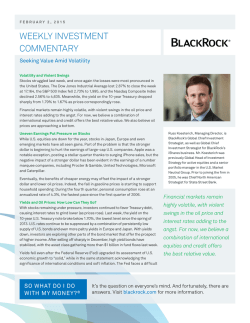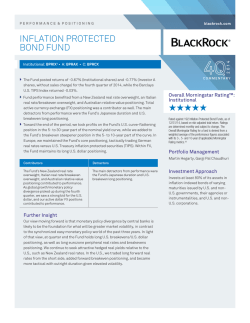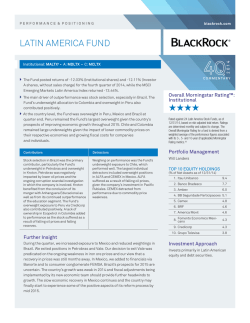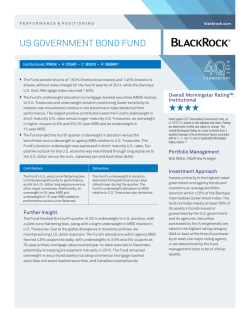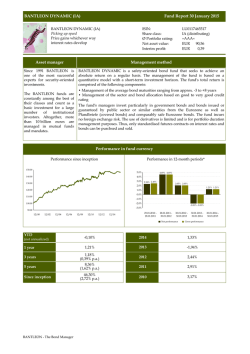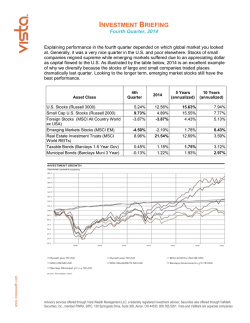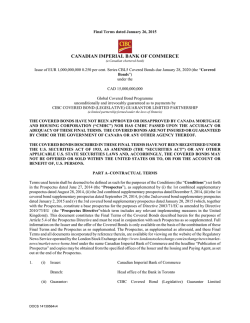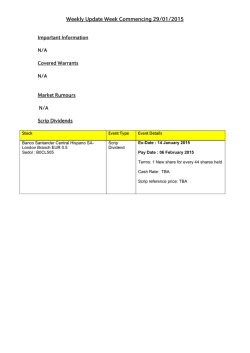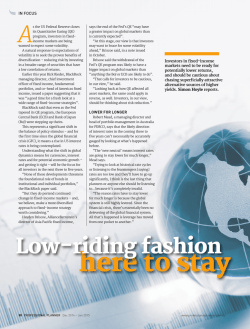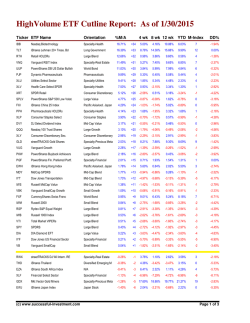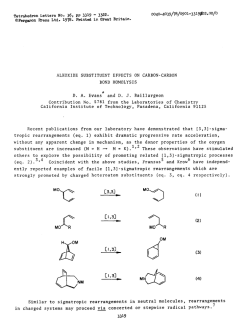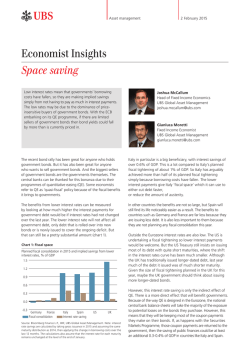
RETHINk YOUR BONDS
rethink your bonds Building Better Bond Portfolios Interest rates may inch up this year, but expect them to be low for some time to come. You can continue to achieve your fixed income goals in this environment by blending multiple bond strategies based on your investing needs. What role do bonds play in your portfolio? DIVERSIFICATION A SOURCE OF PROTECTION INCOME Diversify Risk From Equity Exposure Guard Against Interest Rate Risk and Credit Events Generate Attractive Income Potential In the past, you may have been able to achieve your goals with one strategy. But today, building a bond portfolio requires even greater skills, insight and more tools. That was Then, This is Now. Difference between the 2009 and 2014 bond markets Diversification is harder to find. Interest rate risk is higher. Yield is more elusive. 310% increase in traditional bond fund correlation to stocks.* Duration of traditional core bonds has gone up 46%.† Less than 15% of Bonds Yield more than 4%.‡ * Source: Morningstar. As of 12/31/14. Traditional bond funds are represented by the Morningstar Intermediate-Term Bond fund category average. Stocks are represented by the S&P 500. Based on the 10-year correlation. Past correlations are no guarantee of future correlations. † Source: Barclays Live. As of 12/31/14. Traditional core bonds are represented by the Barclays U.S. Aggregate Bond Index. Data based on modified duration ‡ Sources: BlackRock Investment Institute, Barclays and Thomson Reuters, 201. As of 12/31/14. DIVERSIFICATION Outcome-Oriented Active Strategies Efficient ETFs So What Do I Do with My Money? Bonds are the Ballast in a Diversified Portfolio While navigating the fixed income market remains challenging, bonds continue to serve as a critical ballast to your equity investments. Consider using traditional bond funds to help provide diversification and serve as a buffer from equity market volatility. Bonds Delivered When Stocks Didn’t Negative Stock Market Calendar Years 1929–2014 BlackRock Total Return Fund | M A H Q X 20% 10 iShares Core U.S. Aggregate Bond ETF | AG G 0 % RETURN iShares Core Total USD Bond Market ETF | IU S B -10 -20 -30 -40 -50 ’29 ’30 ’31 ’32 ’34 ’37 ’39 ’40 ’41 ’46 ’53 ’57 ’62 ’66 ’69 ’73 ’74 ’77 ’81 ’90 ’00 ’01 ’02 ’08 Bonds Stocks Source: Morningstar. As of 12/31/14. Past performance does not guarantee or indicate future results. Bond Returns represented by IA SBBI IT Govt Index from 1929 to 1975 and the Barclays U.S. Aggregate Index from 1976 to 2014. Stocks are represented by IA SBBI Large Stock Index from 1929 to 1970 and the S&P 500 from 1970 to 2014. WHEN BONDS MATTERED THE MOST 24 2008 Credit Crisis Returns –37% Source: Morningstar. All data is from 1929–2014 and based on the data in the chart above. NEG AT I V E C A L END A R Y E A R S F O R S TO C K S S TO C K R E T U R N S 92% O F T H O S E Y E A R S , B O ND S HAD P OSITIVE RE TURNS +5.24% B O ND R E T U R N S a POTENTIAL source of protection Outcome-Oriented Active Strategies Efficient ETFs So What Do I Do with My Money? BlackRock Strategic Income Opportunities Fund | B SII X BlackRock Global Long / Short Credit Fund | B G CI X Flexibility is Essential in Changing Bond Markets A nimble bond strategy can help you in today’s changing markets. Investor demand for return, liquidity, and lower volatility makes access to the best fixed income opportunities critical. We suggest you allocate to funds that can quickly navigate rate-sensitive parts of the bond market and credit exposures, such as a flexible, go-anywhere bond portfolio. Want to do it yourself? Consider iBonds ETFs that are designed to mature in a specified year, so you can use them to manage interest rate risk as you would with a portfolio of individual bonds. Flexible Funds Outperformed in Rising and Flat Rate Periods Performance in Different Rate Environments BlackRock Strategic Municipal Opportunities Fund | M A M T X iShares® iBonds® Mature, like a bond. Trade, like a stock. Diversify, like a fund.* PERFORMANCE DURING FLAT RATES PERFORMANCE DURING FALLING RATES Average Rate Move + 60 bps Rate Move 0 bps Average Rate Move -55 bps 3.0 2.15 2.0 1.0 * Each iShares iBonds ETF has a specified maturity date at which time the fund will distribute its assets, less any liabilities, to then current shareholders. Like other ETFs, it trades throughout the day on the stock exchanges at current market prices and holds a variety of investments to help diversify the fund. PERFORMANCE DURING RISING RATES 0.93 1.40 1.03 0.84 0.68 0.47 0.33 0.0 -1.0 -2.0 -1.45 Rising Rates Flat Rates BlackRock Strategic Income Opportunities Fund Falling Rates BlackRock Global Long/Short Credit Fund Barclays U.S. Aggregate Bond Index Source: Morningstar. As of 12/31/14. Based on the institutional shares of the Funds. Rising, Flat, and Declining rate periods are calculated using a proprietary methodology that chooses periods based on specific parameters BlackRock deems sufficient to categorize periods as rising, flat, and declining since 10/1/2011 (BLK GLSC inception).1 BLK Strategic Income Opportunities Fund (inception 2/5/08) Institutional shares performance as of 12/31/14 is 1 Year, 3.89%; 5 years, 5.83%; Since Inception, 5.13%. Total operating expenses as of the most recent prospectus are 0.92%. BLK Global Long/Short Credit Fund (inception 9/30/11) Institutional shares performance as of 12/31/14 is 1 Year, 3.31% and Since Inception, 4.74%. Institutional total operating expenses as of the most recent prospectus are 1.85%. Core Bonds are represented by the Barclays U.S. Aggregate Bond Index. Performance for this index is 1 Year, 3.96; 5 Year, 4.12; 10 Year 4.62. Performance data quoted represents past performance and is no guarantee of future results. Investment returns and principal values may fluctuate so that an investor’s shares, when redeemed, may be worth more or less than their original cost. Current performance may be lower or higher than that shown. All returns assume reinvestment of all dividend and capital gain distributions. Refer to blackrock.com for current month-end performance. income Outcome-Oriented Active Strategies Efficient ETFs So What Do I Do with My Money? BlackRock Multi-Asset Income Fund | B IICX BlackRock High Yield Bond Fund | B H Y I X Look Beyond Traditional Bonds for Income What should an income investor consider doing in a low yield environment? Cast a wider net in pursuit of income. Tactically allocate to high yield funds, and consider flexible income strategies that invest across all income-producing asset classes, like equities and alternative investments, to help provide higher yield. Diversification is not a guarantee against loss (nothing is), but it does spread risk across a broader set of instruments that may respond differently to a given set of market conditions. Income Isn’t What It Used To Be Percent of Bonds Yielding More Than 4% (2001–2014) 100% iShares iBoxx $ High Yield Corporate Bond ETF | H YG 50 0 2001 2002 2003 2004 2005 2006 2007 2008 2009 2010 2011 2012 2013 2014 Sources: BlackRock Investment Institute, Barclays and Thomson Reuters, 201. Based on 20 fixed income indices that represent the bond markets. As of 12/31/14. Past performance is no guarantee of future results. S O WHAT DO I DO WITH MY MONE Y? Evolve Your Portfolio for the New World of Investing Outcome-Oriented Active Strategies Allocate to active strategies when seeking to achieve specific outcomes or goals or when you have conviction in a manager potentially beating a benchmark. Minimize exposure to mutual funds that don’t offer a differentiated return after fees and taxes. Allocate to ETFs when the objective is to attain low-cost, tax-efficient asset class exposure, or to implement a tactical idea. Efficient ETFs What role do bonds play in your portfolio? DiversificatioN Allocate to core bond funds to diversify equity exposure. BlackRock Total Return Fund iShares Core U.S. Aggregate Bond ETF iShares Core Total USD Bond Market ETF MAHQX AG G IU S B a POTENTIAL source of protection Consider flexible bond funds to guard against interest rate and credit events. BlackRock Strategic Income Opportunities Fund BlackRock Strategic Municipal Opportunities Fund BlackRock Global Long / Short Credit Fund B SII X MAMT X B G CI X Do it Yourself: iShares® iBonds® ETFs Income Allocate to higher-yielding solutions to help generate attractive income. BlackRock Multi-Asset Income Fund BlackRock High Yield Bond Fund iShares iBoxx $ High Yield Corporate Bond ETF B IICX BHYIX H YG Why BlackRock® BlackRock helps millions of people, as well as the world’s largest institutions and governments, pursue their investing goals. We offer: }} A comprehensive set of innovative solutions }} Global market and investment insights }} Sophisticated risk and portfolio analytics We work only for our clients, who have entrusted us with managing $4.65 trillion,* earning BlackRock the distinction of being the world’s largest fiduciary investment manager.† Want to know more? blackrock.com * AUM as of 12/31/14. † Source: Pensions & Investments as of 12/31/13. 1 Rising Rates: Counts period if <= 60 day period with at least a 40 bp increase in 10-year treasury from start date to end date..10/01/2011 to 10/27/2011,01/31/2012 to 03/19/2012,07/25/2012 to 09/14/2012,11/16/2012 to 02/13/2013,05/01/2013 to 07/05/2013,10/23/2013 to 12/31/2013. Flat Rates: Ending date rate must be within +/- 2 bps of start date rate, Period must be at least 30 days and no more than 90 days (business days) Variance of rate in the periods must be +/- 15 bps from start date rate on each date over the period (ensures minimal volatility over the period as a whole). 11/17/2011 to 03/06/2012,06/05/2012 to 08/01/2012,10/10/2012 to 12/14/2012,01/03/2013 to 03/25/2013,06/25/2013 to 08/12/2013,09/25/2013 to 11/07/2013,01/30/2014 to 04/29/2014,05/16/2014 to 09/30/2014. Declining Rates: Counts period if <=60 day period with at least a 40 bp decline in 10-year treasury rate from start date to end date;10/27/2011 to 12/19/2011,03/19/2012 to 06/01/2012,03/11/2013 to 05/02/2013,09/05/2013 to 10/23/2013,12/31/2013 to 03/03/2014,07/03/2014 to 10/15/2014. The opinions presented are as of January 2015 and are subject to change. Important Risks for the Strategic Income Opportunities, Strategic Municipal Opportunities, Total Return and Global Long/ Short Credit Funds: Bond values fluctuate in price so the value of your investment can go down depending on market conditions. Fixed income risks include interest rate and credit risk. Typically, when interest rates rise, there is a corresponding decline in bond values. Credit risk refers to the possibility that the bond issuer will not be able to make principal and interest payments. Principal of mortgage- or asset-backed securities normally may be prepaid at any time, reducing the yield and market value of those securities. Obligations of U.S. gov’t agencies are supported by varying degrees of credit but generally are not backed by the full faith and credit of the U.S. gov’t. International investing involves special risks including, but not limited to currency fluctuations, illiquidity and volatility. These risks may be heightened for investments in emerging markets. Non-investment grade debt securities (high-yield/junk bonds) may be subject to greater market fluctuations, risk of default or loss of income and principal than higher-rated securities. Shortselling entails special risks. If the fund makes short sales in securities that increase in value, the fund will lose value. Any loss on short positions may or may not be offset by investing short sale proceeds in other investments. Shares of ETFs trade at market price, which may be greater or less than net asset value. The iShares® iBonds® ETFs (“Funds”) will terminate within the month and year in each Fund’s name. An investment in the Fund(s) is not guaranteed, and an investor may experience losses and/or tax consequences, including near or at the termination date. In the final months of each Fund’s operation, its portfolio will transition to cash and cash-like instruments. As a result, its yield will tend to move toward prevailing money market rates, and may be lower than the yields of the bonds previously held by the Fund and lower than prevailing yields in the bond market. Non-investment-grade debt securities (high-yield/junk bonds) may be subject to greater market fluctuations, risk of default or loss of income and principal than higher-rated securities. An investment in the Fund is not insured or guaranteed by the Federal Deposit Insurance Corporation or any other government agency and its return and yield will fluctuate with market conditions. Correlation is a statistical measure of how two securities move in relation to each other. A perfect correlation of +1 implies movement in lockstep, -1 implies movement in the opposite direction, while a correlation of 0 implies completely random movement. Duration is a measure of a bond’s sensitivity to a change in interest rates. For every year of duration, a bond’s price will move approximately 1% in the opposite direction of a 1% change in interest rates. The iShares Funds are not sponsored, endorsed, issued, sold or promoted by Markit Indices Limited, nor does this company make any representation regarding the advisability of investing in the Funds. BlackRock is not affiliated with Markit Indices Limited. Carefully consider the iShares Funds’ and BlackRock Mutual Funds’ investment objectives, risk factors, charges and expenses before investing. This and other information can be found in the Funds’ prospectuses and, if available, summary prospectuses, which may be obtained by visiting www.iShares.com or blackrock.com. Read the prospectus carefully before investing. ©2015 BlackRock, Inc. All Rights Reserved. BLACKROCK, iSHARES, iBONDS and SO WHAT DO I DO WITH MY MONEY? are registered trademarks of BlackRock, Inc. or its subsidiaries in the United States and elsewhere. All other trademarks are those of their respective owners. Prepared by BlackRock Investments, LLC, member FINRA. Not FDIC Insured • May Lose Value • No Bank Guarantee Lit. No. RETHINKGDE-0115 2937B-RET-0115 / USR-5038
© Copyright 2025
